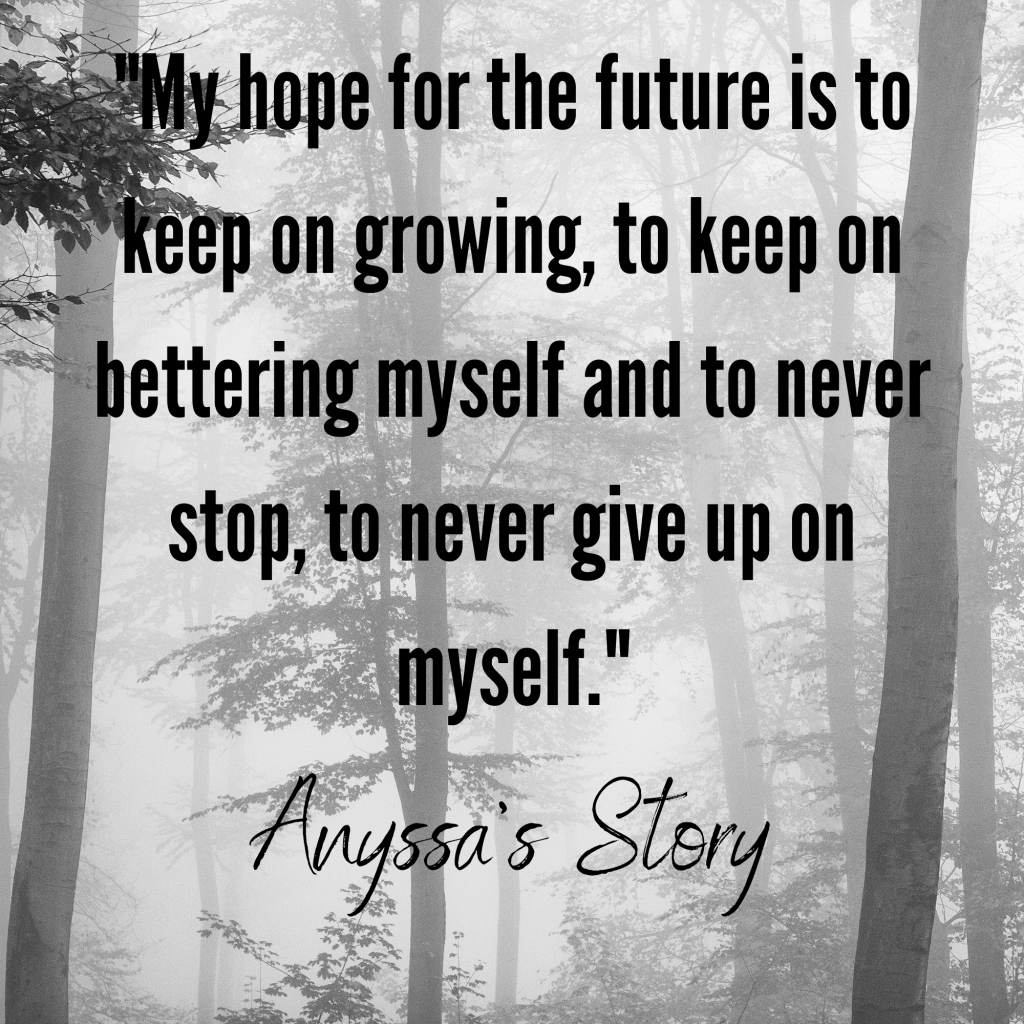
By: Anyssa
A Winding Spiral – My Recovery Story
My name is Anyssa, I’m 20 years old (yes, two decades, so old!), and I’m currently a sophomore in college. I identify as a lesbian in the LGBTQIA+ community and I’m noticed for my masculine-looks and behavior. I’m interested in music, art, skateboarding and writing. I love my family and friends. I’m a very genuine person, loyal, and I have a huge heart. Just imagine a clumsy puppy dog with floppy ears, that’s pretty much me.
Why am I here writing about mental illness? Well, I’d like to answer that by saying that I have been battling with depression and anxiety for 7 years. That’s a long time, but the thing about mental illness is that it’s sort of like a spiral: it has its ups and downs.
I guess my story starts off by saying that I was pretty young when everything began. Everything came about when I was just 13 years old. I was being bullied in middle school for countless of things, like the way I dressed (I was a tomboy) and for simply who I was; this quirky, shy, and loving human being. My peers did not accept me. I was struggling with my sexual orientation, in denial about the fact that I was not heterosexual. I would always go to bed every night, asking myself why I was made the way I was. Girls weren’t supposed to want short hair, masculine clothes, and act masculine. Girls weren’t especially supposed to like other girls. I was very alone, I didn’t have many people to talk to because I was in a position where the bullying would get worse and never would be accepted by anyone. I never had that many friends growing up, so with the friends that I did have, the thought of losing them was heart wrenching to me.
It was wintertime 2009 when I started to self-harm. It became an addiction shortly after, doing it almost all of the time. I didn’t understand why I liked to hurt myself, but it felt good because it was releasing the pain that I held inside of me. Afterwards, I got addicted to taking painkillers; I was taking a big dose every morning before school so I could numb myself for the whole day, not having to think about anything. My thoughts were very negative and trying to combat it with these methods were not helping me at all. In fact, it made things worse.
In March of 2010, I attempted suicide, but I stopped when something inside me spoke, saying that life was giving me a second chance to live and get better. I listened to that voice, and I went to go get help for myself.
Although it took me a year to open up about my experiences, in the fall of 2011, 15 at the time and starting high school, I begged my parents to let me see a therapist. My parents, not really believing in therapeutic practices, managed to see that I was struggling with something inside and allowed me to see a therapist. I found that talking to somebody was very helpful and let me come to terms with what I was dealing with. My addiction with pain-killers stopped briefly. The self-harm was sadly still a thing, but other things were looking positive. I was diagnosed with depression and anxiety. I wanted to avoid taking medication because my parents were against the usage of SSRI’s, and I was against them too because of the risk of becoming suicidal again. I began changing my thought patterns with the start of Cognitive Behavioral Therapy (CBT). It was a good start, but it wasn’t helping me get to the path that I needed to be on.
I was still struggling with my sexual orientation. The “could’ve” part about being gay was true, and the idea of coming out to my parents was scary to me. I was also beginning to question my gender identity. I thought that I was maybe transgender, since people thought I wanted to be a guy because of the way I dressed and acted. I was living with these thoughts in my head every day. I thought I was never going to find out who I was and I was never going to be accepted by my family, friends, and peers. I thought I was never going to make it to see the day that I would be happy with myself. These factors were increasing my depression and anxiety, and on top of that, I was not doing well in school. I was losing motivation to do anything. I continued to self-harm and started abusing painkillers and other medications again. I lived with this mindset before I attempted to commit suicide for the 2nd time in my life in 2014. I was 17 years old.
To this day, I remember the look on my parents’ faces when they found out I has attempted suicide. Their expressions were of pure sadness and distraught. I remember heading to the mental treatment facility. I had those images of their faces permanently glued in my brain.
The facility was almost 3 hours from my home. It was almost like I disappeared. I thought I was never going to get better. I felt alien to the world, like I didn’t belong, and that nothing was going to change. I was the youngest patient in the facility. I made acquaintances with the other patients when we met for group meetings and ate with each other for every meal. I started seeing the on-site psychiatrist, where she diagnosed me with major depression, generalized anxiety disorder (GAD), insomnia, and psychosis-symptoms. I started on anti-depressants and was constantly talking with counselors and nurses about why I was the way I was.
I had visitors when I was at the hospital, which was nice. I got to see my family and family-friends. It was nice knowing that people cared about me and loved me because I thought no one did. I kept thinking that there was a way I was going to get better, and I had to find that way by becoming open to the people I had around me. Harboring the negative thoughts I had was something I didn’t want to do anymore. The stay I had at the treatment facility was the most enlightening experience of my life. I changed so much and was determined to help myself become a healthier, happier person. After a week of intense treatment, I was back out in the world.
After my stay at the treatment, I opened up to people. I was open about my sexual orientation, coming out to all of my family and friends, and I was given amounts of endless support and love. I also was open about my gender identity, and luckily I saw that gender was a spectrum principle and not so much of a binary principle. I learned it was okay to be masculine and female.
I started going back to therapy. I saw that the combination of my medication and therapy was working a lot better than just therapy alone. I started looking forward to my future when I never even thought of it before, gained motivation to do things with my life, and began making positive goals for myself.
I would say that I’m a lot better where I am now than when I was 17. I have had several medication switch-ups over time, and am right now on the lowest dose of medication I’ve been on since I started. The self-harm addiction was difficult to quit when I had gotten out of the hospital, but I am now 9-months clean. I look into doing healthy, positive activities like exercising, listening to music, yoga, and indulging in my different hobbies. I see my struggles as growing points in my life. I was given this tough challenge in my life in order to see that I am strong and can handle anything. I was forced to be self-aware at a young age, and now seeing people my age starting to face struggles themselves. I am now able to offer insight through my experiences and what I’ve gone through to help others like me.
My hope for the future is to keep on growing, to keep on bettering myself and to never stop, to never give up on myself. I learned that there are going to be ups and downs. I will never be on a peak forever, and I’m okay with that. I learned to work towards not being white, or black, but being grey since it’s in the middle. I saw that it’s okay to regress because it only means I’ll be going back up again. I had to work to find my own happiness and not compare my happiness to others. I found that only I could make the changes to my life that I wanted, and that there were always going to be people to help offer me support. I learned that my mental illness is just a part of me and it has helped me become the strong, ambitious person that I am today.
It’s hard to give advice to somebody who is struggling with the same difficulties I have had in the past because everybody’s experiences are very different from one another. The thing that I could say though is that to always have hope, and to never give up. There is so much to live for in this life that we are given. There are always going to be people that are willing to offer support and there are lots of resources out there to get help. I believe that we as humans are much stronger than we think we are, and we never give ourselves credit for getting through every day with the things we do. I would want somebody to look at the things they do that are positives and to focus on those, like getting involved with a hobby like playing an instrument or doing something with art if they’re creative, and to be open about their feelings. Nowadays, more people are becoming supportive and open-minded to mental illnesses out there. I would tell someone that they are definitely not alone.
To someone who is reading this and might be struggling with something, I want to say this: believe in yourself, never lose hope.
Thank you for reading my story, I really appreciate it. I hope through my story, I am spreading the awareness out there about different kinds of mental illnesses and hopefully inspiring somebody out there that there is hope and things get better.
